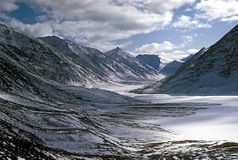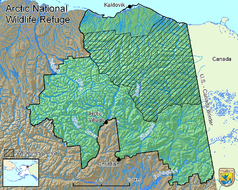Arctic National Wildlife Refuge
| Arctic National Wildlife Refuge | ||
|---|---|---|
| Upper Peter Lake | ||
|
|
||
| Location: | Alaska , United States | |
| Specialty: | largest National Wildlife Refuge in the United States | |
| Next city: | Arctic Village | |
| Surface: | 78,053 km² | |
| Founding: | 1960 | |
The Arctic National Wildlife Refuge ( ANWR ) is the northernmost nature reserve in the USA . The area in the coastal plain of the North Slope in northeast Alaska was placed under nature protection in 1960 by Fred A. Seaton , Minister of the Interior under Dwight D. Eisenhower , and enlarged in 1980 by the Alaska National Interest Lands Conservation Act to a total of 78,053 km², of which the Mollie Beattie Wilderness about 32,374 square kilometers as a wilderness area are reported. The protected area is managed by the World Conservation Union in category IV ( biotope and species protection area ).
It is a unique ecosystem with 45 species of marine and terrestrial mammals, 36 species of fish and 180 species of birds. The area is called Izhik Gwats'an Gwandaii Goodlit (place where all life begins) by the Gwich'in (the northernmost group of Athabaskan indigenous people) because this is where the 152,000 Porcupine caribou herd give birth to their young. The Indians are economically dependent on this herd to this day.
The eastern edge of the refuge forms the border with the Canadian Yukon territory , where the two national parks Vuntut and Ivvavik connect directly .
Up to 16 billion barrels of oil are suspected under the ANWR . The exploitation of these supplies has been a controversial issue since 1977. A moratorium on exploration and exploitation was imposed in 1982, which was extended in 1990 by an executive order from President George HW Bush . In 2005 Ted Stevens tried to allow the use in the Republican- dominated US Senate , but narrowly failed. Since then, the Gwich'in have been fighting to protect the area. In 2008, President George W. Bush campaigned for the United States Congress to allow its use. He argued with US energy security .
Due to the Alaska National Interest Lands Conservation Act , any commercial use of the area must be allowed by Congress itself. In 2017, when Republicans had a majority in both the Senate and the House of Representatives, Congress approved oil and natural gas exploration in up to 8% of the area and asked the Home Office to set the framework for it. Interior Minister David Bernhardt presented a timetable in August 2020 . The first drilling rights could therefore be auctioned by the end of 2020.
→ See also: History of Alaska: Controversy over drilling in the Arctic Refuge
- Arctic National Wildlife Refuge
Web links
- US Fish & Wildlife Service: Arctic National Wildlife Refuge (official site; English)
- Mollie Beattie Wilderness (English)
- Award-winning documentation against oil exploitation in ANWR (English)
Individual evidence
- ↑ World Database on Protected Areas - Arctic National Wildlife Refuge (English)
- ↑ a b Yvonne Bangert: The Alaska National Wildlife Refuge is in danger - The Gwich'in Indians need our support! . ( Memento of the original from December 1, 2016 in the Internet Archive ) Info: The archive link was inserted automatically and has not yet been checked. Please check the original and archive link according to the instructions and then remove this notice. In: gfbv.de (Society for Threatened Peoples), Göttingen, May 14, 2006, accessed on December 1, 2016.
- ↑ US government prepares oil production in Alaska Conservation Area , August 17, 2020





